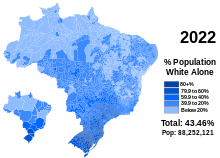
Back Ağ braziliyalılar Azerbaijani Белыя бразільцы Byelorussian Бели хора в Бразилия Bulgarian Blankaj brazilanoj Esperanto Brasileños blancos Spanish Kulit putih Brasil ID 브라질 백인 Korean Урс бразилиæгтæ OS Biali Brazylijczycy Polish Brasileiros brancos Portuguese
 White Brazilians (alone/one race only) in 2022 | |
| Total population | |
|---|---|
| Regions with significant populations | |
| Entire country; highest percentages found in the South Region and Southeast Region[2] | |
| 25,661,895 | |
| 9,251,000 | |
| 8,937,000 | |
| 7,828,000 | |
| 7,591,000 | |
| 5,971,000 | |
| Languages | |
| Mostly Portuguese | |
| Religion | |
| Majority: Catholic Church 66.4% Minority: Protestantism 20.8%, Irreligion 6.7%, Spiritism 2.9%, Other (Jehovah's Witnesses, Brazilian Catholic Apostolic Church The Church of Jesus Christ of Latter-day Saints, Eastern Orthodox Church, Oriental Orthodox Churches, Buddhism, Judaism, Islam, Umbanda) 3.0%[3] | |

White Brazilians (Portuguese: brasileiros brancos [bɾaziˈle(j)ɾuz ˈbɾɐ̃kus]) refers to Brazilian citizens who are considered or self-identify as "white", typically because of European or Levantine[4] ancestry.
The main ancestry of current white Brazilians is Portuguese.[5] Historically, the Portuguese were the Europeans who mostly immigrated to Brazil: it is estimated that, between 1500 and 1808, 500,000 of them went to live in Brazil,[6] and the Portuguese were practically the only European group to have definitively settled in colonial Brazil.
Furthermore, even after independence, the Portuguese were among the nationalities that mostly immigrated to Brazil.[6] Between 1884 and 1959, 4,734,494 immigrants entered Brazil, mostly from Portugal and Italy, but also from Spain, Germany, Poland and other countries;[7] nowadays millions of Brazilians are also descended from these immigrants.[8]
The white Brazilian population is spread throughout Brazil's territory, but its highest percentage is found in the three southernmost states, where 72.6% of the population claims to be White in the censuses, whereas the Southeast region has the largest absolute numbers.[9]
According to the 2022 Census, the states with the highest percentage of white Brazilians are: Rio Grande do Sul (78.4%), Santa Catarina (78.0%), Paraná (64.6%), and São Paulo (57.8%). Other states with significant percentages are: Rio de Janeiro (42%), Mato Grosso do Sul (42.4%) and Espírito Santo (42.06%). São Paulo has the largest population in absolute numbers with 25 million whites.[2]
- ^ "Tabela 9605: População residente, por cor ou raça, nos Censos Demográficos". sidra.ibge.gov.br. Retrieved 11 January 2024.
- ^ a b "Tabela 6408 - População residente, por sexo e cor ou raça (Vide Notas)". Archived from the original on 9 April 2021. Retrieved 17 April 2021.
- ^ https://biblioteca.ibge.gov.br/visualizacao/periodicos/94/cd_2010_religiao_deficiencia.pdf Archived 26 June 2020 at the Wayback Machine, page 148
- ^ Petruccelli, Jose Luis; Saboia, Ana Lucia. "Caracteristicas Etnico-raciais da Populacao Classificacoes e identidades" (PDF). IBGE. p. 53. Retrieved 28 July 2021.
descendentes e os asiáticos [...] libaneses, sírios, entre outros
- ^ Chacón-Duque, Juan-Camilo; Adhikari, Kaustubh; Fuentes-Guajardo, Macarena; Mendoza-Revilla, Javier; Acuña-Alonzo, Victor; Barquera, Rodrigo; Quinto-Sánchez, Mirsha; Gómez-Valdés, Jorge; Everardo Martínez, Paola; Villamil-Ramírez, Hugo; Hünemeier, Tábita; Ramallo, Virginia; Silva de Cerqueira, Caio C.; Hurtado, Malena; Villegas, Valeria; Granja, Vanessa; Villena, Mercedes; Vásquez, René; Llop, Elena; Sandoval, José R.; Salazar-Granara, Alberto A.; Parolin, Maria-Laura; Sandoval, Karla; Peñaloza-Espinosa, Rosenda I.; Rangel-Villalobos, Hector; Winkler, Cheryl A.; Klitz, William; Bravi, Claudio; Molina, Julio; Corach, Daniel; Barrantes, Ramiro; Gomes, Verónica; Resende, Carlos; Gusmão, Leonor; Amorim, Antonio; Xue, Yali; Dugoujon, Jean-Michel; Moral, Pedro; González-José, Rolando; Schuler-Faccini, Lavinia; Salzano, Francisco M.; Bortolini, Maria-Cátira; Canizales-Quinteros, Samuel; Poletti, Giovanni; Gallo, Carla; Bedoya, Gabriel; Rothhammer, Francisco; Balding, David; Hellenthal, Garrett; Ruiz-Linares, Andrés (19 December 2018). "Latin Americans show wide-spread Converso ancestry and imprint of local Native ancestry on physical appearance". Nature Communications. 9 (1): 5388. Bibcode:2018NatCo...9.5388C. doi:10.1038/s41467-018-07748-z. PMC 6300600. PMID 30568240.
- ^ a b Pena, S.D.J.; Bastos-Rodrigues, L.; Pimenta, J.R.; Bydlowski, S.P. (11 September 2009). "DNA tests probe the genomic ancestry of Brazilians". Brazilian Journal of Medical and Biological Research. 42 (10): 870–876. doi:10.1590/S0100-879X2009005000026. PMID 19738982.
- ^ "IBGE - Brasil: 500 anos de povoamento - estatísticas do povoamento - imigração por nacionalidade (1884/1933)". brasil500anos.ibge.gov.br. Archived from the original on 11 August 2020. Retrieved 16 May 2020.
- ^ Leonardo Monasterio (September 2016). "SOBRENOMES E ANCESTRALIDADE NO BRASIL" (PDF). IPEA. Archived (PDF) from the original on 26 October 2019. Retrieved 17 May 2020.
- ^ "PNAD 2006" (PDF). Ibge.gov.br. Archived from the original (PDF) on 22 February 2012. Retrieved 19 August 2017.